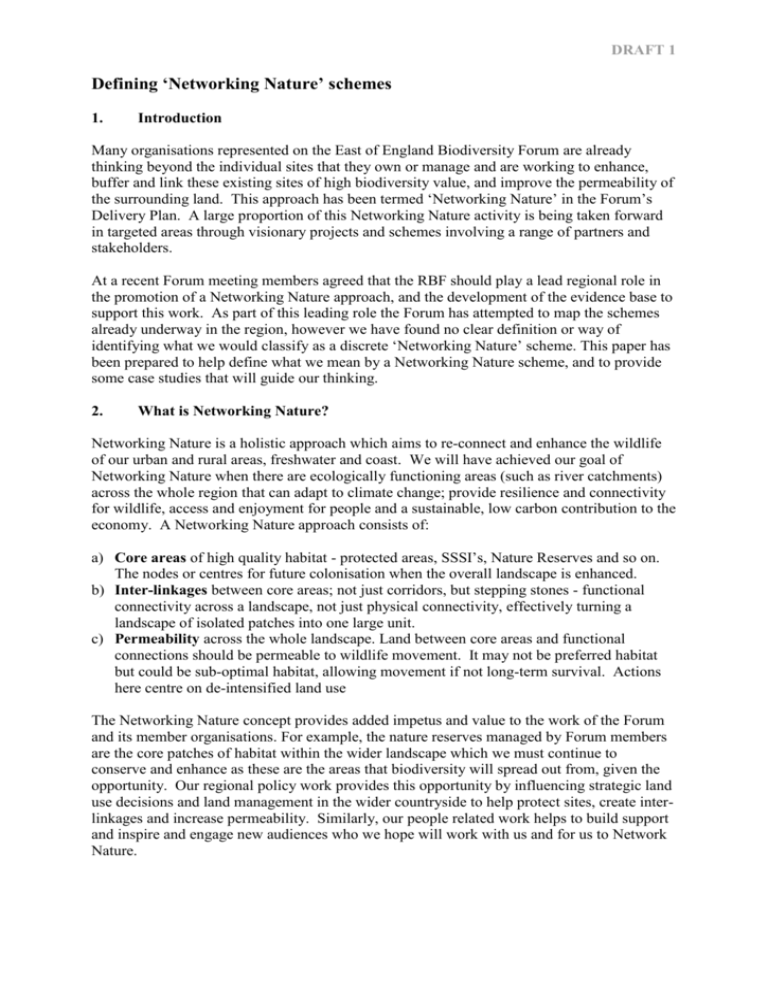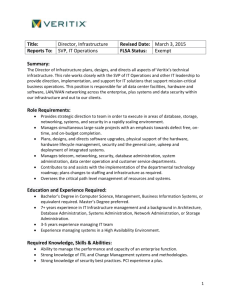Defining Networking Nature Schemes
advertisement

DRAFT 1 Defining ‘Networking Nature’ schemes 1. Introduction Many organisations represented on the East of England Biodiversity Forum are already thinking beyond the individual sites that they own or manage and are working to enhance, buffer and link these existing sites of high biodiversity value, and improve the permeability of the surrounding land. This approach has been termed ‘Networking Nature’ in the Forum’s Delivery Plan. A large proportion of this Networking Nature activity is being taken forward in targeted areas through visionary projects and schemes involving a range of partners and stakeholders. At a recent Forum meeting members agreed that the RBF should play a lead regional role in the promotion of a Networking Nature approach, and the development of the evidence base to support this work. As part of this leading role the Forum has attempted to map the schemes already underway in the region, however we have found no clear definition or way of identifying what we would classify as a discrete ‘Networking Nature’ scheme. This paper has been prepared to help define what we mean by a Networking Nature scheme, and to provide some case studies that will guide our thinking. 2. What is Networking Nature? Networking Nature is a holistic approach which aims to re-connect and enhance the wildlife of our urban and rural areas, freshwater and coast. We will have achieved our goal of Networking Nature when there are ecologically functioning areas (such as river catchments) across the whole region that can adapt to climate change; provide resilience and connectivity for wildlife, access and enjoyment for people and a sustainable, low carbon contribution to the economy. A Networking Nature approach consists of: a) Core areas of high quality habitat - protected areas, SSSI’s, Nature Reserves and so on. The nodes or centres for future colonisation when the overall landscape is enhanced. b) Inter-linkages between core areas; not just corridors, but stepping stones - functional connectivity across a landscape, not just physical connectivity, effectively turning a landscape of isolated patches into one large unit. c) Permeability across the whole landscape. Land between core areas and functional connections should be permeable to wildlife movement. It may not be preferred habitat but could be sub-optimal habitat, allowing movement if not long-term survival. Actions here centre on de-intensified land use The Networking Nature concept provides added impetus and value to the work of the Forum and its member organisations. For example, the nature reserves managed by Forum members are the core patches of habitat within the wider landscape which we must continue to conserve and enhance as these are the areas that biodiversity will spread out from, given the opportunity. Our regional policy work provides this opportunity by influencing strategic land use decisions and land management in the wider countryside to help protect sites, create interlinkages and increase permeability. Similarly, our people related work helps to build support and inspire and engage new audiences who we hope will work with us and for us to Network Nature. DRAFT 1 3. What is a Networking Nature Scheme? Much of the uncertainty about what constitutes a Networking Nature scheme appears to be around the issue of scale, as terms such as ‘landscape-scale’ are used to describe how we will achieve our goal. Landscape-scale conservation describes the process to achieve Networking Nature. This reflects the need to take a strategic approach to conservation, by linking existing sites of high biodiversity and managing those processes that operate throughout the whole landscape such as water, planning, grazing or invasive species. One of the tools of landscape-scale conservation is the restoration and re-creation of habitats. There are a range of mechanisms for delivering landscape-scale conservation, such as acquiring new land, advising farmers and landowners, working with business and influencing the public sector. Policy change at national, regional and local levels is also required to ensure a favourable policy framework. When facing competing land use pressures and climate change it is important for us, as people involved in the conservation of biodiversity, to move beyond conservation business as usual, and to employ our full range of skills to deliver the goal of Networking Nature. A Networking Nature scheme should therefore: i) ii) iii) iv) v) be identified strategically to enhance resilience and connectivity, at a visionary scale, using a robust process with best available information focus on landscapes or areas, rather than individual habitat patches, to work with and influence the drivers and process that act on an area employ a multi-disciplinary approach (e.g. acquisition, advice, community engagement and involvement) deliver a range of significant environmental benefits for people often associated with improvements to society and the local economy have organisational commitment in the long term 3. Case studies of Networking Nature schemes 3.1 Nene Valley Vision - Wildlife Trust (Beds, Cambs, Northants and Peterborough) The Wildlife Trust is leading the way in securing land and engaging with existing and new communities to ensure a future for wildlife and a high quality environment for people in the Nene Valley. The Trust manages several sites along the river; some large and some tiny gems. By safeguarding the land, creating corridors along which wildlife can move, and engaging with local people, the Trust can provide a future for wildlife in the valley. DRAFT 1 3.2 Wicken Fen - National Trust The Wicken Fen Vision is an ambitious plan to create a new nature reserve covering around 56 square kilometres (22 square miles) between Cambridge and Wicken Fen. This will be the biggest project of its kind in lowland England - it won't happen overnight, in fact it will take up to 100 years. Today The National Trust owns 930 hectares (around 2,300 acres) in the area. We are here to look after special places, for ever, for everyone. together we can make this area of Cambridgeshire become a special place for wildlife, for local people and for visitors. Paul Wilkinson October 2008


